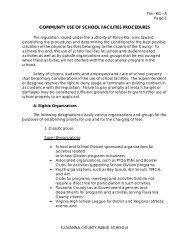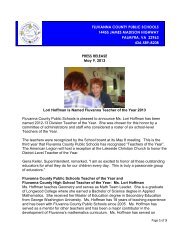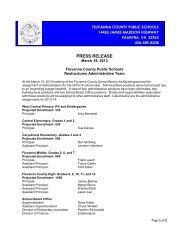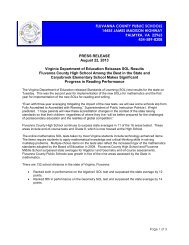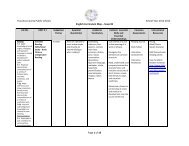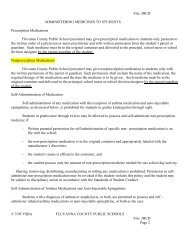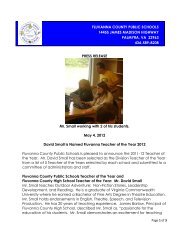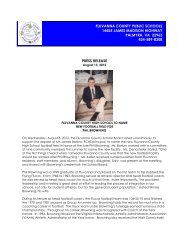K Curriculum Map 2013-14 - Fluvanna County Public Schools
K Curriculum Map 2013-14 - Fluvanna County Public Schools
K Curriculum Map 2013-14 - Fluvanna County Public Schools
Create successful ePaper yourself
Turn your PDF publications into a flip-book with our unique Google optimized e-Paper software.
1<br />
2<br />
3<br />
4<br />
A B C D E F G H I<br />
<strong>Fluvanna</strong> <strong>County</strong> <strong>Public</strong> <strong>Schools</strong> School Year <strong>2013</strong>-20<strong>14</strong><br />
Literacy <strong>Curriculum</strong> <strong>Map</strong> – Kindergarten<br />
Quarter 4<br />
Organizing Strand VA SOL Suggested Pacing Essential Questions and<br />
Vocabulary<br />
Oral Language K.1 All Vocabulary: Listen,<br />
Participate, Poem, Rhyme<br />
Essential Questions: How<br />
do we act when we listen to<br />
someone talking? Can you<br />
repeat after me?<br />
Essential Skills and Essential Understandings<br />
Instructional<br />
Resources<br />
Assessments<br />
(including mastery)<br />
• listen to texts read aloud and ask and answer questions for further understanding.<br />
PALS Emergent / Observations<br />
• participate in choral and echo speaking and recitation of short poems, rhymes, songs, and stories with Beginning Reader Use of anecdotal<br />
repeated patterns and refrains.<br />
and Transitional records<br />
• generate ideas to develop a group language experience narrative .• dictate sentences about a group<br />
Lesson Planpassword<br />
experience for a group language experience narrative (e.g., a story about a class field trip).<br />
required<br />
• dictate an experience or story to create an individual language experience narrative (e.g., a story about a family<br />
pet).<br />
• use drama to retell familiar stories, rhymes, and poems (e.g., storytelling with role play or puppets).<br />
• participate in creative dramatics, such as classroom songs, plays, skits, and group activities designed to give<br />
students frequent opportunities for listening and speaking.<br />
• use complete sentences that include subject, verb, and object when speaking.<br />
5<br />
K.2 All Vocabulary: number words, • understand and use number words in conversations, during partner and group activities, and during teacherdirected<br />
instruction.<br />
color words, shape words,<br />
size words, positional words: • use words to describe or name people, places, feelings, and things during partner and group activities and<br />
during teacher-directed instruction.<br />
on, off, in, out, over, under,<br />
• use size, shape, color, and spatial words to describe people, places, and things during group or individual<br />
between, beside, after, next<br />
activities and during teacher-directed instruction.<br />
Essential Questions: What<br />
• use words to show direction and location (e.g., on, off, in, out, over, under, between, and beside).<br />
color is the shape? What • use a variety of words to describe the actions of characters and people in real and make-believe settings in<br />
shape is red? How do you feel response to stories or class activities.<br />
when…<br />
• recognize when they do not understand a word or phrase and seek clarification by asking a peer or an adult.<br />
What do you do when you • use vocabulary from content areas during partner or group activities and during teacher-directed instruction.<br />
need help?<br />
Where is the...?<br />
Where is the third picture in<br />
this pattern?<br />
6<br />
Oral Language K.3 K.3 all Vocabulary:Question<br />
Directions<br />
Essential Questions: How<br />
To be successful with this standard, students are expected to<br />
• speak audibly in complete sentences, expressing thoughts, feelings and ideas clearly.<br />
• verbally express needs through direct requests.<br />
do we talk with one another?<br />
• participate in a range of collaborative discussions building on others’ ideas and clearly expressing their own<br />
How do we act when we are<br />
taking turns? How can I show<br />
(e.g., one-on-one, small group, teacher- led).<br />
• initiate conversations with peers and teachers in a variety of school settings.<br />
• listen attentively to others in a variety of formal and informal settings involving peers and adults.<br />
that I am listening to the • participate in partner or group activities, (i.e., conversations, discussions, book chats, retellings of stories,<br />
directions? Can I do what my choral speaking, language experience narratives, morning routines, dramatizations and role play).<br />
teacher asks the first time?<br />
Can I listen for 2 things to do<br />
and do them?<br />
• listen to and discuss a variety of texts that reflect the Virginia Standards of Learning in English, history and<br />
social science, science, and mathematics.<br />
• wait for their turn to speak, allowing others to speak without unnecessary interruptions.<br />
Can you ask a how question? • maintain conversation on topic through multiple exchanges.<br />
Can you ask a why question? • in group and partner discussions clearly state a thought related to the book or topic being discussed.<br />
• begin to use voice level, phrasing, and intonation appropriate for the language situation.<br />
• match language to the purpose, situation, environment, and audience.<br />
• repeat and follow one- and two-step oral directions.<br />
• ask who, what, where, when, why, and how questions to obtain information, seek help, or clarify something not<br />
understood.<br />
Rhyming Activities Student Observations<br />
Word Games Anecdotal Records<br />
Phonological<br />
Awareness Activities<br />
Poems<br />
COW Poem charts<br />
Songs on charts<br />
Class Discussions<br />
7<br />
1
3<br />
Phonological<br />
Awareness<br />
A B C D E F G H I<br />
K.4 K.4 All Vocabulary: Rhyme, To be successful with this standard, students are expected to<br />
Syllables, Parts, Sentence, • focus on speech sounds.<br />
Beginning, Ending<br />
• demonstrate the concept of word by segmenting spoken sentences into individual words.<br />
• segment a word into individual syllables by clapping hands or snapping fingers.<br />
Essential Questions: What<br />
• discriminate between large phonological units of running speech, sentences, words, and syllables.<br />
rhymes with __? What<br />
• identify a word that rhymes with a spoken word.<br />
beginning sound do you<br />
• supply a word that rhymes with a spoken word.<br />
hear? What ends the same as • produce rhyming words and recognize pairs of rhyming words presented orally.<br />
clock? How amny words do • generate rhyming words based on a given rhyming pattern.<br />
you hear? How many syllables • supply an appropriate rhyming word to complete a familiar nursery rhyme or a predictable text with rhyming<br />
do you hear? How many lines.<br />
sounds do you hear in this • blend and segment consonants and rimes of spoken words (e.g., /b/- /oat/ = boat, black = /bl/- /ack/).<br />
word?<br />
• blend and segment multisyllabic words into syllables (e.g., the teacher asks students to say robot without the<br />
/ro-/ and students respond with /bot/).<br />
• recognize that a word can be segmented into individual speech sound units.<br />
• recognize how phonemes sound when spoken in isolation.<br />
• recognize similarities and differences in beginning and ending sounds of words.<br />
• determine the order of speech sounds in a given word by answering the following questions:<br />
COW Activities<br />
• produce a word that has the same beginning or ending sound as a spoken word (e.g., /sock/- /sun/ and /hot/-<br />
/rat/).<br />
• identify pictures of objects whose names share the same beginning or ending sound.<br />
• sort pictures or objects whose names share the same beginning or ending sound.<br />
• blend three spoken phonemes to make words (e.g., the teacher says /c/ /a/ /t/, and the student blends the<br />
phonemes to say the word cat).<br />
• segment one-syllable words into onset and rime (e.g., the teacher says the word hat and when asked, the<br />
student verbally says /h/ for the onset and /-at/ for the rime.) Students are not expected to know the terms onset<br />
and rime.<br />
• segment one-syllable words into speech sound units (e.g., the teacher says the word bat, and the student<br />
segments the sounds /b/- /a/- /t/).<br />
• substitute the beginning consonant to make a new word (e.g., the teacher asks the student to say cat, but in<br />
the place of /c/ she asks them to say /b/, and the student responds with bat).<br />
8<br />
Reading<br />
Concept of Print<br />
Concept of Word<br />
K.5 The student will<br />
understand how print is<br />
organized and read..<br />
d) Follow words from left to<br />
right and from top to bottom<br />
on a printed page.<br />
e) Match voice with print<br />
(concept of word).<br />
K.5 d,e N4<br />
K.5 a-e review<br />
Vocabulary: Cover, front, To be successful with this standard, students are expected to<br />
back, book, title page, pages, • hold printed material the correct way.<br />
top, bottom, illustrations • identify the front and back covers of a book.<br />
• distinguish the title page from all the other pages in a book.<br />
Essential Questions: How<br />
• turn pages appropriately.<br />
do you hold a book? Can you<br />
• distinguish print from pictures.<br />
touch the title? Can you find<br />
• follow text with a finger, pointing to each word as it is read from left to right and top to bottom.<br />
the title page?<br />
• locate lines of text, words, letters, and spaces.<br />
• match voice with print in syllables, words, and phrases.<br />
• locate and name periods, question marks, and exclamation points.<br />
PALS website Pals Quickchecks as<br />
(Instructional needed<br />
Resources)<br />
Concept of word<br />
instruction and<br />
Guided Reading<br />
Small Group<br />
Instruction should<br />
include writing for<br />
sounds based on<br />
student instructional<br />
needs. Words<br />
Their Way<br />
9<br />
K.6 The student will<br />
demonstrate an<br />
understanding that print<br />
conveys meaning.<br />
a) Identify common signs<br />
and logos.<br />
b) Explain that printed<br />
materials provide<br />
information.<br />
c) Read and explain own<br />
writing and drawings.<br />
d) Read his/her name and<br />
read fifteen meaningful,<br />
concrete words.<br />
K.6 a,b,c,d<br />
Taught: N4<br />
Assessed: N4<br />
Vocabulary:sign, writing,<br />
drawings, logos, name,<br />
words, sight words<br />
Essential Questions:<br />
Can you find your name?,<br />
What does this sign tell us?<br />
Can you tell about your<br />
picture? Can you read what<br />
you wrote?<br />
To be successful with this standard, students are expected to<br />
• apply knowledge that print conveys meaning.<br />
• recognize and identify common signs, logos, and labels.<br />
• explain that printed material provides information.<br />
• read and explain their own drawings and writings.<br />
• locate commonly used words and phrases in familiar text.<br />
• recognize a selection of high-frequency and sight words as well as read fifteen meaningful, concrete words.<br />
(Each student may know a different set of words.)<br />
• recognize and identify their own first and last names.<br />
student observations<br />
Anecdotal records<br />
10<br />
2
A B C D E F G H I<br />
3<br />
Phonics<br />
K.7 The student will develop K.7 a,b,c, d,<br />
Vocabulary: Alphabet, To be successful with this standard, students are expected to<br />
Primary MAP Skillsan<br />
understanding of basic All Assessed<br />
letters, words, vowel,<br />
• recognize and name rapidly and with ease uppercase and lowercase letters in sequence and in random order. Beginning and<br />
phonetic principles.<br />
consonant, upper case, lower • match uppercase and lowercase letter pairs.<br />
Ending Sounds<br />
• produce the usual sounds of consonants, short vowels and initial consonant digraphs.<br />
a) Identify and name the<br />
case, capital, beginnning,<br />
• demonstrate concept of word by:<br />
uppercase and lowercase<br />
middle, ending sounds<br />
letters of the alphabet.<br />
Essential Questions:<br />
b) Match consonant, short<br />
Where is the lower case__? syllable.<br />
vowel, and initial consonant<br />
What sound does it make? • write the grapheme (letter) that represents a spoken sound.<br />
digraph sounds to<br />
Can you point to the words in • use basic knowledge of one-to-one letter-sound correspondences by producing sounds for each consonant.<br />
appropriate letters.<br />
the poem/ book?<br />
• isolate initial consonants in single-syllable words (e.g., /t/ is the first sound in top).<br />
c) Demonstrate a speech-toprint<br />
Which word ends with the __ • identify long and short sounds with common spellings for the five major vowels.<br />
match through accurate<br />
sound? What is the<br />
• distinguish between similarly spelled words by identifying sounds of the letters that differ.<br />
finger-point reading in<br />
beginning sound? Ending • segment onsets and rimes and begin to blend to form the words.<br />
familiar text that includes<br />
sound? Middle sound?<br />
words with more than one<br />
syllable.<br />
d) Identify beginning<br />
consonant sounds in singlesyllable<br />
words.<br />
11<br />
Vocabulary<br />
12<br />
K.8 The student will expand<br />
vocabulary.<br />
a) Discuss meanings of<br />
words.<br />
b) Develop vocabulary by<br />
listening to a variety of texts<br />
read aloud.<br />
Taught: N1-N4<br />
Assessed: Ongoing through<br />
teacher observation<br />
Vocabulary: meaning To be successful with this standard, students are expected to<br />
Essential Questions: What • discuss meanings of specific words including synonyms and antonyms in partner, group and teacher-guided<br />
does this word mean? How<br />
settings.<br />
• identify new meanings for familiar words and apply them accurately (e.g., knowing water as a drink and<br />
can we tell? Do you think<br />
learning the verb water the flowers).<br />
some words can mean more<br />
• sort common objects into categories (e.g., shapes, foods) to gain a sense of the concepts the categories<br />
than one thing? Can you think<br />
represent.<br />
of a word that is the opposite • use common adjectives to distinguish objects (e.g., the small red square; the shy white cat). (Students are not<br />
of that word?<br />
required to know the term adjective at this level.)<br />
Think Aloud<br />
Equity Shot Read<br />
Aloud<br />
3
A B C D E F G H I<br />
3<br />
Reading<br />
K.9 The student will<br />
Wk 3 K.9b Relate previous Vocabulary: Author, To be successful with this standard, students are expected to<br />
Suggested Read<br />
Comprehension demonstrate comprehension experiences to what is read.K.9f Illustrator, illustrations,Words, • identify the roles of the author and the illustrator of selected texts.<br />
Alouds:<br />
Fiction<br />
of fictional texts.<br />
Retell familiar stories using BME. pictures, Write, draw,Predict, • make ongoing predictions based on illustrations and text.<br />
Closer<br />
• describe the relationship between illustration and the story (e.g., what moment in the story does the illustration<br />
a) Identify what an author does Graphic Org: Making Connections question, answere, story,<br />
Butterfly-NF<br />
depict).<br />
and what an illustrator does. Graphic, Story <strong>Map</strong> (Include poem, information, problem,<br />
Wonderful Worms<br />
• link knowledge from their own experiences to make sense of and talk about a text.<br />
b) Relate previous experiences B,M,E)<br />
solution<br />
Fuzzy Wuzzy,<br />
• give evidence that they understand the meaning of what is being read aloud, including the who, what, when,<br />
to what is read.<br />
Wk 6, 7 K. 9 e Use story Essential Questions: What where, why, and how.<br />
Creepy Crawly<br />
c) Use pictures to make language in discussions in does an author do? Who • ask and respond to simple questions about the content of a book.<br />
When It Comes To<br />
predictions.<br />
retellings. (Focus on character writes the words? What does • use vocabulary from a story in discussions and retellings.<br />
Bugs<br />
d) Begin to ask and answer details and descriptions.) an illustrator do? Who draws • retell a story from pictures or text in their own words, arranging the events in the correct sequence (beginning, Eency, Weency<br />
questions about what is read. K.9g Discuss characters, setting, the pictures?<br />
middle, and end).<br />
Spider<br />
e) Use story language in and events. Graphic Organizer: What is an illustration? When • use words to sequence events (e.g., before, after, and next).<br />
Everything Grows<br />
discussions and retellings. Characer Detail Graphic<br />
you look at these pictures • produce artwork or a written response (letters or phonetically spelled words) that demonstrates<br />
The Ants and The<br />
f) Retell familiar stories,<br />
comprehension of a story that they have heard read aloud.<br />
Wk 8, 9 Review all previously what do you think will<br />
• use descriptive language to talk about characters, settings, and events of a story.<br />
Grasshopper<br />
using beginning, middle, and taught SOLs based on formative happen? What will this story<br />
Anansi, and the<br />
• recognize various types of fictional texts (e.g., storybooks, poems).<br />
end.<br />
assessments.<br />
be about?<br />
Biggest, Sweetest<br />
g) Discuss characters,<br />
What was the problem? What<br />
Melon<br />
setting, and events.<br />
K.9c, d, g Assessed: Checklist happened in the story?<br />
The Fearsome Best<br />
as needed<br />
Did they solve the problem?<br />
The Ants Came<br />
K.9b, e, f Assessed: Ongoing What happened before?<br />
Marching<br />
teacher observation<br />
After? Next?<br />
Decodable Books<br />
Kip the Ant<br />
The Big Ram<br />
What Can Hop?<br />
13<br />
Reading<br />
Comprehension<br />
NonFiction<br />
<strong>14</strong><br />
K.10 The student will<br />
demonstrate comprehension<br />
of nonfiction texts.<br />
a) Use pictures to identify<br />
topic and make predictions.<br />
b) Identify text features<br />
specific to the topic, such as<br />
titles, headings, and<br />
pictures.<br />
Wk 1,2 K.10 b Identify text<br />
features titles, headings, and<br />
pictures and extend with table of<br />
contents, glossary, index, labels,<br />
and captions.<br />
Graphic Org: Text Features<br />
Checklist<br />
Wk 4, 5 K.10 a Use pictures to<br />
identify topic and make predictions<br />
K. 10 b Identify text features title,<br />
heading, pictures. Ask and<br />
answer questions based on the<br />
content of the book and the text<br />
features.<br />
Graphic Org: Question Mark<br />
Graphic<br />
Wk 8, 9 Review all previously<br />
taught SOLs based on formative<br />
assessments.<br />
Vocabulary: nonfiction, text,<br />
text features, predict,<br />
predictions<br />
Essential Questions: When<br />
we look at this picture, what<br />
do we think this book about?<br />
What does this picture remind<br />
you of?<br />
Have you ever done this, seen<br />
this? Where have you seen<br />
this before?<br />
To be successful with this standard, students are expected to<br />
• make ongoing predictions based on graphics and text.<br />
• relate pictures and illustrations to the text in which they appear.<br />
• link knowledge from their own experiences to make sense of and talk about a text.<br />
• identify the topic of a nonfiction selection.<br />
• ask and respond to simple questions about the content of a book.<br />
• discuss simple facts and information relevant to the topic.<br />
• identify text features including titles, headings and pictures in text.<br />
• identify the author and illustrator of a text and define the role of each in presenting the ideas or information in a<br />
text.<br />
EX: Performance<br />
Assessments -where<br />
is the title? Where is<br />
the heading on this<br />
page?<br />
4
A B C D E F G H I<br />
3<br />
Writing<br />
K.11 The student will print in K.11a,b<br />
Vocabulary: uppercase, To be successful with this standard, students are expected to<br />
Handwriting Without Student Products<br />
manuscript.<br />
lowercase, Alphabet, words, • use appropriate pencil grip.<br />
Tears<br />
Student observations<br />
a) Print uppercase and<br />
first, last, name,Print, words, • print upper- and lower-case letters of the alphabet legibly and independently.<br />
• use manuscript letter formation.<br />
lowercase letters of the<br />
left, right, top, bottom<br />
• use manuscript number formation.<br />
alphabet independently.<br />
Essential Questions:<br />
• form the letters of and space their first and last names.<br />
b) Print his/her first and last<br />
Can you write your letters<br />
• write their first and last names for a variety of purposes.<br />
names.<br />
correctly?<br />
• capitalize the first word in a sentence and the pronoun I.<br />
Can you print your first name<br />
correctly?<br />
15<br />
Writing<br />
16<br />
Technology<br />
K.12 The student will write to<br />
communicate ideas for a<br />
variety of purposes.<br />
a) Differentiate pictures from<br />
writing.<br />
b) Draw pictures and/or use<br />
letters and phonetically spelled<br />
words to write about<br />
experiences.<br />
c) Use letters and beginning<br />
consonant sounds to spell<br />
phonetically words to describe<br />
pictures or write about<br />
experiences.<br />
d) Write left to right and top to<br />
bottom.<br />
K.13 The student will use<br />
available technology for<br />
reading and writing.<br />
K.12 a, b, c, d Essential Questions: How<br />
can I write about this picture?<br />
What can I write about this<br />
picture? Can I write using<br />
letters?<br />
N2-N4<br />
Vocabulary: mouse,<br />
computer, headphones, Log<br />
in, password<br />
Essential Questions:How<br />
can I use the computer to<br />
read? To write?<br />
To be successful with this standard, students are expected to<br />
K-2 VDOE Writing<br />
• distinguish print from pictures.<br />
• write daily for a variety of purposes (e.g., practicing formation of alphabet letters, labeling, and journal writing). resources, list of<br />
• write on assigned and/or self-selected topics.<br />
mentor texts, list<br />
• use writing, dictation, and drawing to compose informative/explanatory texts that introduce a topic (what they<br />
of suggested mini<br />
are writing about), state an opinion or some facts and provide some information (e.g., My favorite book is …).<br />
• use writing, dictation, and drawing to narrate an event.<br />
lessons<br />
• generate text to communicate and make meaning by creating drawings, letter strings, scribbles, letter<br />
approximations, or other graphic representations, as well as phonetically spelled words.<br />
• write left to right and top to bottom.<br />
To be successful with this standard, students are expected to<br />
• use available digital tools for reading and writing.<br />
• ask and respond to questions about material presented through various media formats.<br />
• share their writing with others.<br />
17<br />
18<br />
19<br />
5



